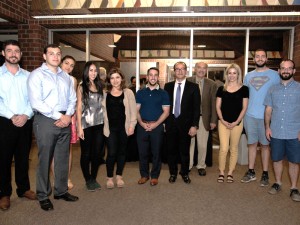
Photo: Hourig Attarian
Diana Gasparyan
Staff Writer
Dr. Khatchig Mouradian, Kazan Visiting Professor of Armenian Studies at Fresno State, spoke on the topic of, “Genocide and Humanitarian Resistance in Ottoman Syria, 1915-1917,” as the first of his three-part public lectures series on “Genocide and Resilience.” The lecture, which took place on Tuesday, September 20, offered new insight into the Armenian Genocide and attracted many who were curious to learn more about the resistance pursued by the Armenian deportees in Ottoman Syria during World War I.
Early in his study of the Armenian Genocide, Dr. Mouradian realized the important roles of concentration camps in the perpetration of the Genocide. The Syrian desert region of Der Zor, for example was considered to be the “Armenian Auschwitz.” Dr. Mouradian was especially intrigued by the fact that this was the largest massacre site during the Genocide, yet there had been few scholarly studies of the region. Because of this, he began to focus more on Syria, narrowing his research to the period from when deportees arrived in Syria to the concluding massacres in Der Zor in 1916.
Researching this topic posed a few challenges and Dr. Mouradian explained how the usual sources, such as missionary accounts, consular accounts, and diplomatic material were typically nonexistent in the middle of a desert.
This was especially true in the case of Der Zor, since the Ottoman Turkish state had banned any reporting from the area. In addition, many documents in the Ottoman archives have not been easily accessible.
“I used material from both Armenian and Ottoman archives, missionary accounts, and diplomatic records to reconstruct that history,” said Dr. Mouradian.
One previously untapped primary source that Dr. Mouradian utilized in his research was the archives of the Armenian Apostolic Church in Aleppo. He discussed how the Church organized relief committees to help the arriving Armenians, who were in terrible condition. The minutes from those committee meetings contain valuable information pertaining to the help given to the deportees, such as purchases made, dates, and lists of the deportees they assisted. These lists also include the region each person came from, giving Mouradian an idea of where most Armenians were deported from. “It’s like having a camera in Aleppo when the deportees were arriving,” said Dr. Mouradian.
The Armenian Genocide is more known for what the oppressors were doing to the victims, but Dr. Mouradian introduced the idea of how the victims fought back in their own ways against the oppressors. He discussed how hiding, running, and trying to escape were all forms of resistance, and how the Armenian people did not go down without a fight.
“People always say the last thing that leaves a person is hope. I would say that the last thing to leave a person is the will to resist.”
Dr. Mouradian also stated that most people continue resisting even when they have lost all hope, which is a universal trend in history.
Dr. Mouradian’s research highlights this “will to resist,” which changes the way historians have traditionally viewed the Armenian Genocide by giving the victims more agency.
“I hope to help us think about the Armenian Genocide, not as the history of people being only oppressed, killed, and massacred, but as people who tried to resist.”
 Hye Sharzhoom Armenian Action
Hye Sharzhoom Armenian Action